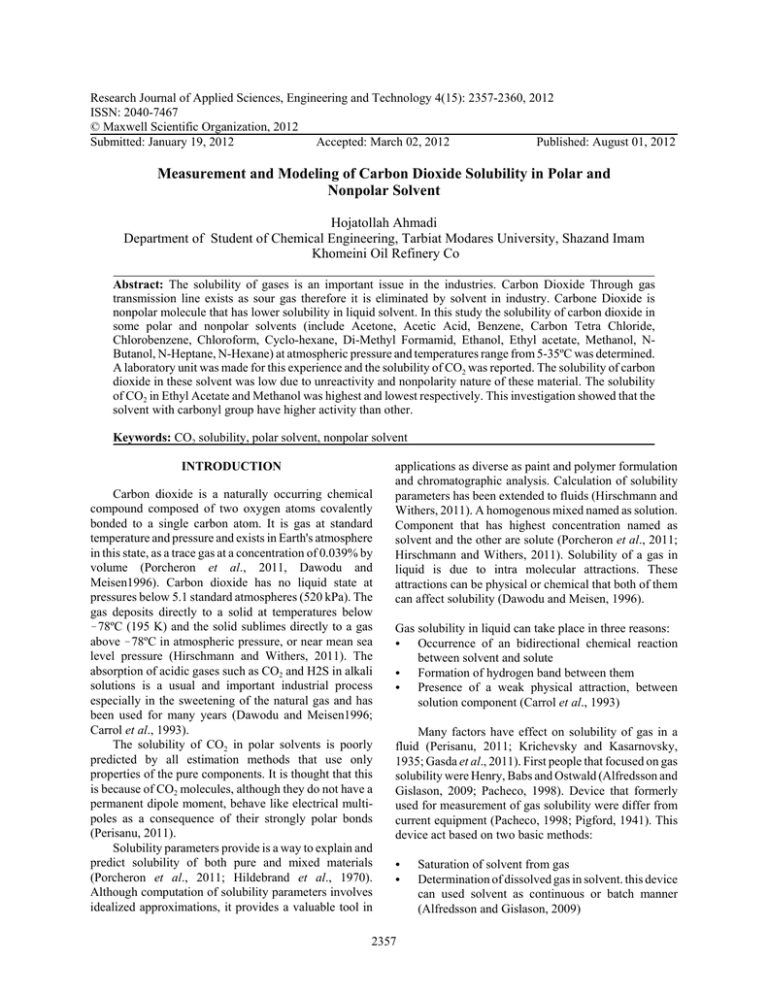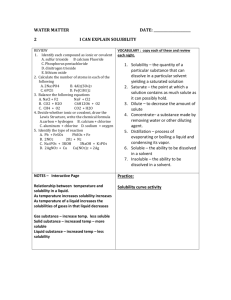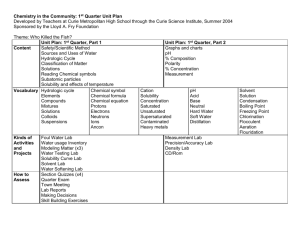Research Journal of Applied Sciences, Engineering and Technology 4(15): 2357-2360,... ISSN: 2040-7467
advertisement

Research Journal of Applied Sciences, Engineering and Technology 4(15): 2357-2360, 2012 ISSN: 2040-7467 © Maxwell Scientific Organization, 2012 Submitted: January 19, 2012 Accepted: March 02, 2012 Published: August 01, 2012 Measurement and Modeling of Carbon Dioxide Solubility in Polar and Nonpolar Solvent Hojatollah Ahmadi Department of Student of Chemical Engineering, Tarbiat Modares University, Shazand Imam Khomeini Oil Refinery Co Abstract: The solubility of gases is an important issue in the industries. Carbon Dioxide Through gas transmission line exists as sour gas therefore it is eliminated by solvent in industry. Carbone Dioxide is nonpolar molecule that has lower solubility in liquid solvent. In this study the solubility of carbon dioxide in some polar and nonpolar solvents (include Acetone, Acetic Acid, Benzene, Carbon Tetra Chloride, Chlorobenzene, Chloroform, Cyclo-hexane, Di-Methyl Formamid, Ethanol, Ethyl acetate, Methanol, NButanol, N-Heptane, N-Hexane) at atmospheric pressure and temperatures range from 5-35ºC was determined. A laboratory unit was made for this experience and the solubility of CO2 was reported. The solubility of carbon dioxide in these solvent was low due to unreactivity and nonpolarity nature of these material. The solubility of CO2 in Ethyl Acetate and Methanol was highest and lowest respectively. This investigation showed that the solvent with carbonyl group have higher activity than other. Keywords: CO2 solubility, polar solvent, nonpolar solvent INTRODUCTION Carbon dioxide is a naturally occurring chemical compound composed of two oxygen atoms covalently bonded to a single carbon atom. It is gas at standard temperature and pressure and exists in Earth's atmosphere in this state, as a trace gas at a concentration of 0.039% by volume (Porcheron et al., 2011, Dawodu and Meisen1996). Carbon dioxide has no liquid state at pressures below 5.1 standard atmospheres (520 kPa). The gas deposits directly to a solid at temperatures below !78ºC (195 K) and the solid sublimes directly to a gas above !78ºC in atmospheric pressure, or near mean sea level pressure (Hirschmann and Withers, 2011). The absorption of acidic gases such as CO2 and H2S in alkali solutions is a usual and important industrial process especially in the sweetening of the natural gas and has been used for many years (Dawodu and Meisen1996; Carrol et al., 1993). The solubility of CO2 in polar solvents is poorly predicted by all estimation methods that use only properties of the pure components. It is thought that this is because of CO2 molecules, although they do not have a permanent dipole moment, behave like electrical multipoles as a consequence of their strongly polar bonds (Perisanu, 2011). Solubility parameters provide is a way to explain and predict solubility of both pure and mixed materials (Porcheron et al., 2011; Hildebrand et al., 1970). Although computation of solubility parameters involves idealized approximations, it provides a valuable tool in applications as diverse as paint and polymer formulation and chromatographic analysis. Calculation of solubility parameters has been extended to fluids (Hirschmann and Withers, 2011). A homogenous mixed named as solution. Component that has highest concentration named as solvent and the other are solute (Porcheron et al., 2011; Hirschmann and Withers, 2011). Solubility of a gas in liquid is due to intra molecular attractions. These attractions can be physical or chemical that both of them can affect solubility (Dawodu and Meisen, 1996). Gas solubility in liquid can take place in three reasons: C Occurrence of an bidirectional chemical reaction between solvent and solute C Formation of hydrogen band between them C Presence of a weak physical attraction, between solution component (Carrol et al., 1993) Many factors have effect on solubility of gas in a fluid (Perisanu, 2011; Krichevsky and Kasarnovsky, 1935; Gasda et al., 2011). First people that focused on gas solubility were Henry, Babs and Ostwald (Alfredsson and Gislason, 2009; Pacheco, 1998). Device that formerly used for measurement of gas solubility were differ from current equipment (Pacheco, 1998; Pigford, 1941). This device act based on two basic methods: C C 2357 Saturation of solvent from gas Determination of dissolved gas in solvent. this device can used solvent as continuous or batch manner (Alfredsson and Gislason, 2009) Res. J. Appl. Sci. Eng. Technol., 4(15): 2357-2360, 2012 In this study tried to give the Co2 solubility in some solvent includes Acetone, Acetic Acid, Benzene, Carbon Tetra Chloride, Chlorobenzene, Chloroform, Cyclohexane, Di-Methyl Formamid, Ethanol, Ethyl acetate, Methanol, N-Butanol, N-Heptane, N-Hexane. Therefore, the Co2 concentration in this solvent was obtained based on a designed plan in the laboratory. Materials and methods for this experiment are shown in the below. MATERIALS AND METHODS This experiment performed in two main steps by following Fig. 1: Degassing: In first step we need that solvent be empty of any gas by degassing apparatus. About 5 CC solvent dropped in a flask and placed in the apparatus correctly. After establishment the device, turned the heater on for 15 min and continue the degassing based on manufacturer instruction. Solubility measurement: Set the test temperature in suitable points as needed. Fill the pomp siring from degassing solvent and put it in its place on measurement device. Wash the device using tested gas and perform the procedure based on apparatus manufacturer instruction. For calculation, after consumption of specified volume of gas, read the konometer and record the time of consumption. Repeat this action for 3-4 times and terminate the experiment after ensuring that the results are similar. Finally, by having the test time, can determine usage solvent. Record the dissolved gas directly from device monitor and then we can compute the gas solubility. If solubility is very high, decrease the solvent injection speed from siring and repeat the test for 3-4 speed. If needed solvent for specified amount of gas be fixed in repeated experiment, it showed the accuracy of test. All step of experiment performed in one atmosphere pressure and must be fixed thought out of the test time. Absorption or desorption of CO2 was determined from the gas phase material balance using the measured inlet and outlet gas concentrations. Periodically, liquid samples were withdrawn from a sample port close to the reactor outlet and analyzed for total carbon dioxide by acidic evolution into a CO2 analyzer (Bishnoi, 2000; Kaganoi, 1997; Mshewa and Rochelle, 1995; Pacheco, 1998). Fig.1: Schematic of the plan to determine the concentration of carbon dioxide Amine solution was also added in or withdrawn periodically from the sample port to keep the liquid level constant in the wetted wall column. CO2 feed: CO2 is nonpolar molecule (12) and buy from Sabalan Gas Corporation as 100 kg capsule with purity about 99.5%. Solvent: In this experiment we use fourteen type of solvent and supplied from Merck Corporation in purity of 99.9%. In this study the solubility of CO2 was assessed in solvent named as: Acetone, Acetic Acid, Benzene, Carbon Tetra Chloride, Chlorobenzene, Chloroform, Cyclo-hexane, Di-Methyl Formamid, Ethanol, Ethyl acetate, Methanol, N-Butanol, N-Heptane, N-Hexane. Vapor pressure and density: To determine the vapor pressure we used the Antoine vapor pressure equation (Gutmann and Simmons, 1950). Solvent density gained from manufacturer. Table 1 show the name, formula and other physical property of solvent. Furthermore vapor pressure of solvent in 5-35oC showed in Table 2. Table 1: Physiochemical property of solvent N Solvent Formula 1 Acetone C3H6O 2 Acetic acid C2H4O2 3 Benzene C6H6 4 Carbon tetra chloride CCL4 5 Cholrobenzene C6H5CL 6 Cholroform CHCL3 7 Cyclo-hexane C6H12 8 Di-methyl formamid C3H7NO 9 Ethanol C2H5OH 10 Ethyl acetate C4H8O2 11 Methanol CH4O 12 N-butane C4H9OH 13 N-heptane C7H16 14 N-hexane C6H14 Green and Perry Robert (2008) Molecular wight 58.08 60.06 78.11 153.82 112.76 119.38 84.16 73.10 46.07 88.10 32.04 117.7 100.21 86.17 Density 0.791 1.050 0.874 1.594 1.110 1.492 779 0.920 0.790 0.900 0.790 0.800 0.690 0.6567 Table 2: Vapor pressure in different temperature Vapor pressure --------------------------------------------------15oC 25oC 35oC Solvent 5oC Acetone 0.119 0.193 0.301 0.455 Acetic acid 0.009 0.015 0.026 0.043 Benzene 0.046 0.810 0.129 0.198 Carbon tetra chloride 0.057 0.093 0.148 0.226 Cholrobenzene 0.004 0.007 0.013 0.022 Cholroform 0.097 0.157 0.245 0.369 Cyclo-hexane 0.046 0.077 0.123 0.198 Di-methyl formamid 0.001 0.001 0.001 0.001 Ethanol 0.022 0.044 0.080 0.140 Ethyl acetate 0.042 0.074 0.123 0.192 Methanol 0.051 0.094 0.164 0.275 N-butane 0.002 0.004 0.008 0.017 N-heptane 0.020 0.036 0.060 0.097 N-hexane 0.078 0.127 0.199 0.302 Green and Perry Robert (2008) 2358 Res. J. Appl. Sci. Eng. Technol., 4(15): 2357-2360, 2012 RESULTS The experimental values of CO2 solubility in temperature between 5-35oC per atmospheric pressure are listed in Table 3. This table showed that the solubility of CO2 is very low. The CO2 is a nonpolar molecule that its carbon atoms have no vein for corporation in chemical reaction. From data mentioned above, CO2 solubility is a physical solubility and thus is very slight. Figure 2 show the result as clustered column. According Fig. 2, among all solvent, Ethyl Acetate has highest solubility in all temperature. After that, Di Methyl Formamid, Acetone and N-butanol have highest solubility respectively. Resulted from laboratory data, solvent that have carbonyl group, have more solubility activity than other. The following figure shows the solubility of Co2 v.s temperature. According to the Fig. 3, the solubility of Co2 reduces by temperature increase after 15ºC. Table 3: CO2 solubility in different temperature Solubility of carbon dioxide -----------------------------------------------------Solvent 5ºC 15ºC 25ºC 35ºC Acetone 99.55 110.11 99.55 --Acetic acid 94.60 93.81 94.60 89.46 Benzene 62.69 84.46 62.69 52.71 Carbon tetra chloride 65.64 85.85 65.64 --Cholrobenzene 77.76 92.18 77.76 71.21 Cholroform 56.74 103.61 56.74 26.42 Cyclo-hexane --65.45 47.04 42.21 Di-methyl formamid 98.01 119.76 98.01 62.31 Ethanol 58.81 72.00 58.81 38.46 Ethyl acetate 148.38 173.73 148.38 96.88 Methanol 42.70 67.19 42.70 46.48 N-butane 97.64 116.35 97.64 73.93 N-heptane 77.99 94.86 77.99 --N-hexane 86.37 99.29 86.37 77.49 5 oC 15 oC o 25 C o 30 C Fig. 3: The solubility of Co2 V.s temperature DISCUSSION Comparison of study results with Bishnoi (2000) revealed that the accuracy of our experiment is very high. One of the best models for predicting the solubility is the Scatuhard Hilbrand, regular solution hypothesis. This model is suitable for none or slightly polar solvent. By comparison with this model showed that theoretical solubility often is 2 times greater than experimental data (Gutmann and Simmons, 1950). This phenomenon revealed the importance of using and accurate and valid solubility measurement device for industrial applications. In this study elevating the test temperature in nearly all case led to decrease in solubility. In temperature lower than zero, solubility tend to increase more than other temperature. The solubility of CO2 in polar solvents is poorly predicted by all estimation methods that use only properties of the pure components. It is thought that this is because CO2 molecules, although they do not have a permanent dipole moment, behave like electrical multipoles as a consequence of their strongly polar bonds. An equation, proposed in a previous study, for estimating the activity coefficient of a nonpolar gas dissolved in a polar liquid is modified by adding a term containing the quadrupole moment of the gas molecule. Errors in estimating gas solubilities on that basis are less than 20%, except for the solvents in which specific interactions (e.g., acid-base interactions) are present (Perisanu, 2011). N-Hexane N-butane N-Heptane Methanol Ethyl Acetate Cyclo-Hexane Di-methyl formamid Ethanol Cholrobenzene Cholroform Acetone Acetic acid Benzeze Carbon tetra chloride REFERENCES Fig. 2: Clustered column of CO2 solubility in different temperature Alfredsson, H.A. and S.R. Gislason, 2009. CarbFix-CO2 Sequestration in Basaltic Rock: Chemistry of the Rocks and Waters at the Injection Site. Hellisheidi, SW-Iceland, Goldschmidt Conference Abstracts, A26. Hirschmann, B.M. and A.C. Withers, 2011. CO2 solubility in Martian basalts and Martian atmospheric evolution. Geochimica et Cosmochimica Acta, 75(20): 5987-6003. Bishnoi, S., 2000. Carbon dioxide absorption and solution equilibrium in piperazine activated methyldiethanolamine. Ph.D. Thesis, the University of Texas at Austin. 2359 Res. J. Appl. Sci. Eng. Technol., 4(15): 2357-2360, 2012 Dawodu, O.F. and A. Meisen, 1996. Effects of composition on the performance of alkanolamine blends for gas sweetening. Can. J. Chem. Eng., 74: 960. Gutmann, F. and L.M. Simmons, 1950. A theoretical basis for the antoine vapor pressure equation. J. Chem. Phys., 18: 696. Gasda, S.E., J.M. Nordbotten and M.A. Celia, 2011. Vertically averaged approaches for CO2 migration with solubility trapping. Water Resour. Res., 47: W05528. Green, D.W. and R.H. Perry, 2008. Perry's Chemical Engineers' Handbook. 8th Edn., McGraw-Hill. Hildebrand, J.H., J.M. Prausnitz and R.L. Scott, 1970. Regular and Related Solutions. Van Nostrand Reinhold Co, New York. Carrol, J.J., F.Y. Jou, A.E. Mather and F.D. Otto, 1993. A model for the solubility of light hydrocarbons in water and aqueous solutions of alkanolamines. J. Chem. Eng. Data, 38: 75. Kaganoi, S., 1997. Carbon Dioxide Absorption in Methyl di ethanolamine with piperazine or Di ethanolamine: Thermodynamics and rate measurements. M.S. Thesis, the University of Texas at Austin. Krichevsky, I.R. and J.S. Kasarnovsky, 1935. Thermodynamical calculations of solubilities of nitrogen and hydrogen in water at high pressure. J. Am. Chem. Soc., 57: 2168. Mshewa, G. and T. Rochelle, 1995. Carbon Dioxide Desorption/absorption with Aqueous Mixture of Methyldiethanolamine and Diethanolamine at 40ºC to 120ºC”. Ph.D. Thesis, the University of Texas at Austin. Pacheco, M.A., 1998. Mass transfer, kinetics and ratebased modeling of reactive absorption. Ph.D. Thesis, the University of Texas at Austin. Porcheron, F., A. Gibert, P. Mougin and A. Wender, 2011. High throughput screening of CO2 solubility in aqueous monoamine solutions. Environ. Sci. Technol., 1545(6): 2486-2492. Pigford, R.L., 1941. Counter-diffusion in a wetted wall column. Ph.D. Thesis, the University of Illinois, Urbana, Illinois. Perisanu, S.T., 2011. Estimation of solubility of carbon dioxide in polar solvents. J. Solution Chem., 30(2): 183-192. 2360





